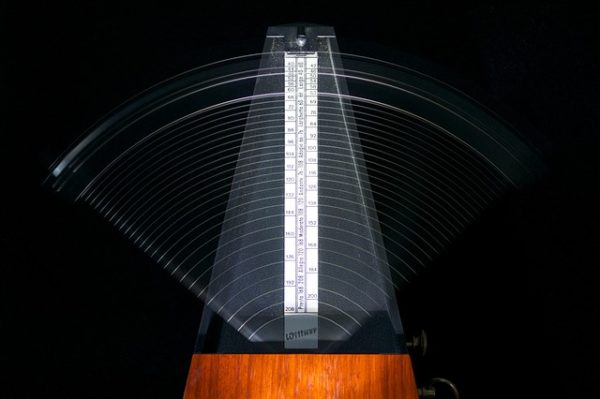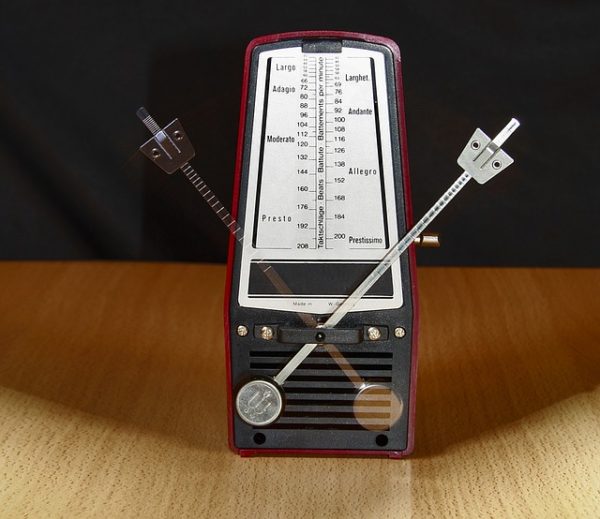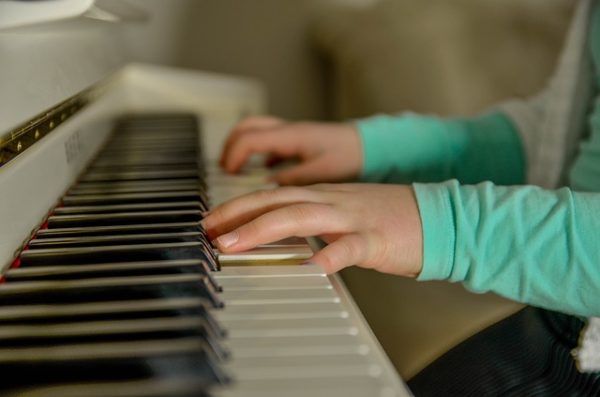
メトロノームはピアノに限らず、楽器をより楽しく効果的に練習することができる便利なツールです。
1分あたりの鳴る回数を指定して、安定した間隔で鳴らすことができます。メトロノームを使うことで、楽器をリズムよく演奏する練習ができるのです。
その結果としてリズム感を習得することができ、その楽器の演奏を効率よく上達させることができます。バンドやピアノの連弾など、他の楽器などとの共演もスムーズに行えるようになるでしょう。
メトロノームなしでもテンポを一定に、リズムよく演奏するスキルは身につきますが、メトロノームを使ったほうがより効率的に練習できますので、今回はメトロノームやメトロノームを使った練習法を紹介していきます。
メトロノームの歴史

そもそもメトロノームの歴史についてザックリと、簡単に説明します。
ここは単なる雑学ですので、読み飛ばしてもらっても問題ありません。
メトロノームは1分間に鳴る音の数を選ぶことができます。
つまり1分間が正確にわからなければ作ることは不可能でした。
時計の歴史は紀元前まで遡ることになりますが、メトロノームは振り子型の時計(「大きな古時計」に出てきそうな振り子が下にある時計)が作られたあとに出来上がります。
この振り子型の時計をモデルに、振り子の上に付いた重さで振り子のスピードを調整していったのが現在のメトロノームです。
現在の形のメトロノームを最初に使ったのは、有名なベートーベンでした。ベートーベンは晩年、耳が聞こえませんでした。耳が聞こえない中で、リズムを正確に把握するためにメトロノームの振動を頼りに曲を作っていったのです。
これがきっかけとなり、他の音楽家たちもメトロノームを使っていったのです。
メトロノームの導入

最初にメトロノームを使うときは、いくつかの異なるテンポを聞くだけでいいです。メトロノームの数字が小さいほどテンポが遅く、数字が大きければテンポが早くなることを聞いて覚えてみましょう。
何回か聞いた後に、そのカチカチとしたタイミングに合わせて、拍手を鳴らしたり、足を踏んだりしたりしください。拍手やタップでテンポを維持することができたら、メトロノームに合わせてピアノで1つの音符を演奏し、そのカチカチの音ごとに1つの音符を弾いていきます。安定したリズムを保つことは難しいことなので、我慢強く何度もやってみましょう。
メトロノームを使って練習してみる

メトロノームは単に体のリズム感を養うだけではありません。ピアノの演奏においてはそれは指のトレーニングに繋がります。
どんなに脳がそのリズム、テンポを理解していても、指の筋肉が追いつかないと意味がありません。
まずは簡単な曲からメトロノームを使って演奏してみましょう。
「そのリズムに沿って鍵盤が押せているか」はもちろんですが、「そのリズムに沿って鍵盤が離せているか」を意識して演奏しましょう。
初心者は音を鳴らすための鍵盤を押す動作ばかり意識してしまう傾向があります。残念ながら初心者の演奏とプロの演奏の大きな違いは、音のつながりです。鍵盤を離す動作が雑になるまえに、メトロノームを使って正しいタイミングを掴みましょう。
メトロノームの練習に飽きたときには

メトロノームを使った練習というのはとても単調に感じやすく、特に子供にとってはすぐに飽きる練習の一つです。
そんなときは自分にアメとムチをもたせるルールを作って、練習に変化をつけましょう。
例えば、
- 基準となるテンポの+20を上限のテンポ、-20を下限のテンポの値とする。
- 基準のテンポから始まり、演奏中に間違えるたびにメトロノームのテンポを「5」だけ下げる。
- 間違えることなく演奏することができたらテンポを「5」上げる。
- 上限となるテンポで3回間違えることなく演奏できればクリア
といったルールです。
もちろん、テンポには上限と下限を決めておいてください。
あまりにも早すぎるテンポや遅すぎるテンポの場合、かえって演奏しにくくなり時間の無駄になってしまいます。
上限や下限の値には演奏を楽しめる範囲内で設定してみてください。
このように練習に変化をつけることで、脳がリフレッシュされ、飽きを軽減させることができます。
このような練習を繰り返していくことで自然とリズム感を脳や手が覚えていきます。
みなさんもルールを作って楽しく練習しましょう。
最後に
リズム感を習得し、テンポよく演奏できるようになるには、長い練習時間が必要です。しかし、これはピアノを演奏する上では避けては通れない関門です。
しかしこれは、練習時間を費やすだけの価値があります。
始めて練習する曲をマスターするまでの時間を短くするだけでなく、他の人が演奏する楽器や声にスムーズに合わせることができるのです。
メトロノームを使うことで、これを習得するまでの練習時間を短縮させることができます。

コメントを残す